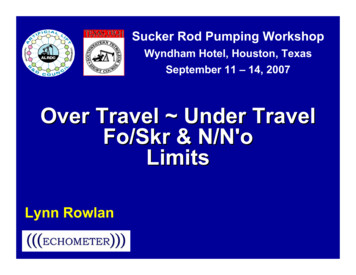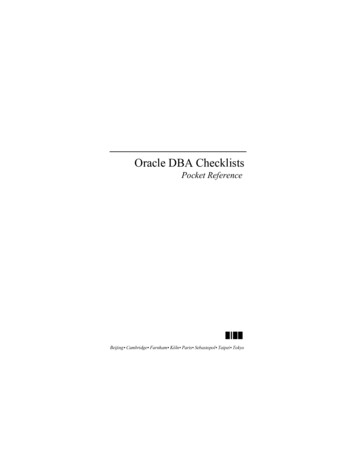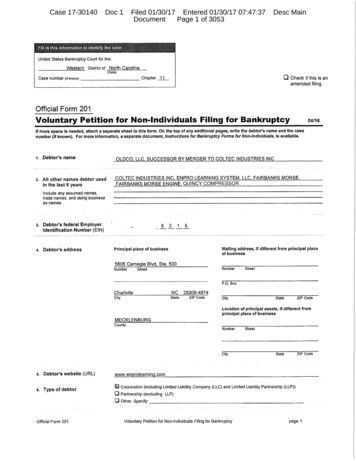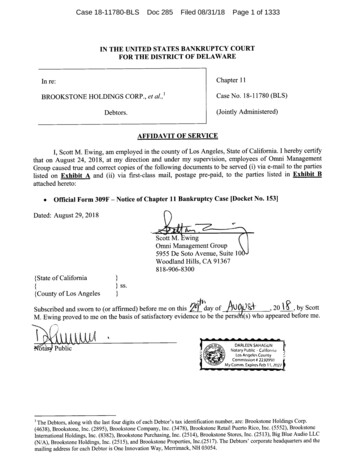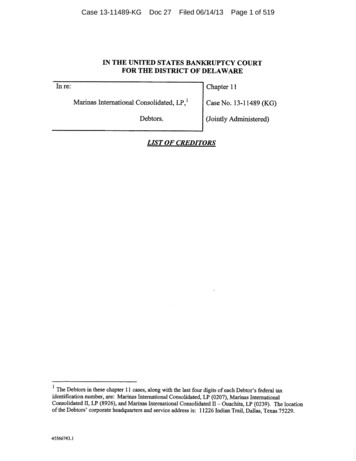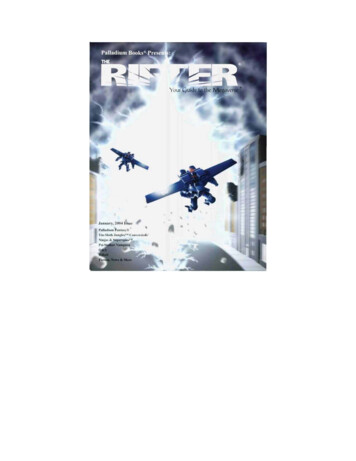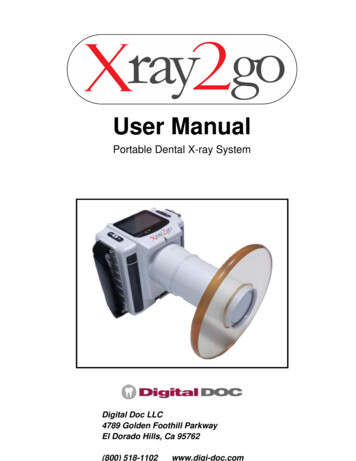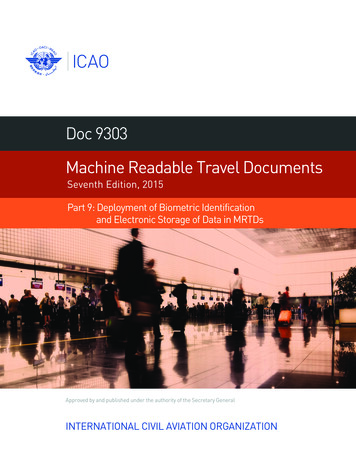
Transcription
Doc 9303Machine Readable Travel DocumentsSeventh Edition, 2015Part 9: Deployment of Biometric Identificationand Electronic Storage of Data in MRTDsApproved by and published under the authority of the Secretary GeneralINTERNATIONAL CIVIL AVIATION ORGANIZATION
Doc 9303Machine Readable Travel DocumentsSeventh Edition, 2015Part 9: Deployment of Biometric Identificationand Electronic Storage of Data in MRTDsApproved by the Secretary General and published under his authorityINTERNATIONAL CIVIL AVIATION ORGANIZATION
Published in separate English, Arabic, Chinese, French, Russianand Spanish editions by theINTERNATIONAL CIVIL AVIATION ORGANIZATION999 Robert-Bourassa Boulevard, Montréal, Quebec, Canada H3C 5H7Downloads and additional information are available at www.icao.int/Security/FAL/TRIPDoc 9303, Machine Readable Travel DocumentsPart 9 — Deployment of Biometric Identification and Electronic Storage of Data in MRTDsOrder No.: 9303P9ISBN 978-92-9249-797-2 ICAO 2015All rights reserved. No part of this publication may be reproduced, stored in aretrieval system or transmitted in any form or by any means, without priorpermission in writing from the International Civil Aviation Organization.
DOCUMENT CHANGE RECORDDoc 9303, Part 9DATENO.6/12/161SECTION/PAGES AFFECTEDTitleRevised “eMRTDs” to “MRTDs”Page 115.1 Characteristics of the Contactless IC — Added reference to ISO/IEC14443 application profilePage 136. Test Methodologies for (e)MRTDS — Reference updated for ISO/IEC18745-2Pages 13and 147. References (Normative) — References updated for ISO/IEC 10373-6,18745-2, 14443-1 to 4AppendixPrevious section A.1 (Location of the IC and its Associated Antenna)revised and moved to Doc 9303-10, Appendix BThe designations employed and the presentation of the material in this publication donot imply the expression of any opinion whatsoever on the part of ICAO concerning thelegal status of any country, territory, city or area or of its authorities, or concerning thedelimitation of its frontiers or boundaries.(iii)
TABLE OF CONTENTS1.SCOPE .12.eMRTD .12.12.22.32.4Conformance to Doc 9303 .Validity Period for an eMRTD .Chip Inside Symbol .Warning regarding Care in Handling an eMRP .1123BIOMETRIC IDENTIFICATION .33.13.23.33.43.5ICAO Vision on Biometrics .Key Considerations.Key Processes with respect to Biometrics .Applications for a Biometric Solution .Constraints on Biometric Solutions .34567THE SELECTION OF BIOMETRICS APPLICABLE TO eMRTDs .73.4.4.14.2Primary Biometric: Facial Image .Optional Additional Biometrics .710STORAGE OF THE BIOMETRIC AND OTHER DATA IN A LOGICAL FORMATIN A CONTACTLESS IC .115.15.25.3Characteristics of the Contactless IC .Logical Data Structure .Security and Privacy of the Stored Data .1112126.TEST METHODOLOGIES FOR (e)MRTDS .137.REFERENCES (NORMATIVE) .13APPENDIX TO PART 9 — PROCESS FOR READING eMRTDS (INFORMATIVE) .App-15.A.1A.2A.3A.4Precautions in eMRTD manufacture .Reading both the OCR and the data on the IC .Reading geometries.Reading process .App-1App-1App-1App-2(v)6/12/16No. 1
1.SCOPEThe Seventh Edition of Doc 9303 represents a restructuring of the ICAO specifications for Machine Readable TravelDocuments. Without incorporating substantial modifications to the specifications, in this new edition Doc 9303 has beenreformatted into a set of specifications for Size 1 Machine Readable Official Travel Documents (TD1), Size 2 MachineReadable Official Travel Documents (TD2), and Size 3 Machine Readable Travel Documents (TD3), as well as visas.This set of specifications consists of various separate documents in which general (applicable to all MRTDs) as well asMRTD form factor specific specifications are grouped.This Part 9 of Doc 9303 is based on the Sixth Edition of Doc 9303 Part 1, Volume 2, Section II (2006), as well as theThird Edition of Doc 9303 Part 3, Volume 2 (2008).Part 9 defines the specifications, additional to those for the basic MRTD set forth in Parts 3, 4, 5, 6, and 7 of Doc 9303,to be used by States wishing to issue an electronic Machine Readable Travel Document (eMRTD) capable of beingused by any suitably equipped receiving State to read and to authenticate data relating to the eMRTD itself andverification of its holder. This includes mandatory globally interoperable biometric data that can be used as an input tofacial recognition systems, and, optionally, to fingerprint or iris recognition systems. The specifications require theglobally interoperable biometric data to be stored in the form of high-resolution images on a high-capacity contactlessintegrated circuit (IC), the IC also being encoded with a duplicate of the MRZ data. The specifications also permit thestorage of a range of optional data at the discretion of the issuing State. Since the use of the contactless IC isindependent of the size of the document, all specifications apply to all eMRTD sizes in their electronically enabled form.Differences between eMRTD formats relate to the MRZ, with consequences for the storage of the MRZ in thecontactless IC. These differences are indicated in the specifications of the Logical Data Structure in Doc 9303-10.2.eMRTDNote.— The terms MRTD and eMRTD are used in this document as a generic reference to all types ofMachine Readable Travel Documents in, respectively, optical character reading and electronically enabled forms. Theterms TD1, TD2 and TD3 refer to the different form factors of MRTDs. All eMRTDs referred to in this Part areelectronically enabled.2.1Conformance to Doc 9303An electronic MRTD (eMRTD) SHALL conform in all respects to the specifications provided in Doc 9303.2.2Validity Period for an eMRTDThe validity period of an eMRTD is at the discretion of the issuing State; however, in consideration of the limiteddurability of documents and the changing appearance of the document holder over time, a validity period of not morethan ten years is RECOMMENDED. States MAY wish to consider a shorter period to enable the progressive upgradingof the eMRTD as the technology evolves.1
2Machine Readable Travel Documents2.3Chip Inside SymbolDoc 9303-9 focuses on biometrics in relation to Machine Readable Travel Documents, using the term “eMRTD” todenote such biometrically-enabled and globally-interoperable MRTD. Any MRTD that does not comply with thespecifications given in Doc 9303 may not be called an eMRTD and shall not display the Chip Inside symbol.All eMRTDs shall carry the following symbol:Figure 1.Chip Inside symbolAn electronic file of the symbol is available from the ICAO website. The symbol SHALL only appear on an eMRTD thatcontains a contactless integrated circuit, with a data storage capacity of at least 32 kB, that is encoded in accordancewith the Logical Data Structure (Doc 9303-10) with, as a minimum, the MRZ data in Data Group 1 and a facial image asspecified in this part in Data Group 2, with all entered data secured with a digital signature as specified in Doc 9303-11.Unless an eMRTD conforms to these minimum requirements, it SHALL NOT be described as an eMRTD nor display theChip Inside symbol. The symbol shall appear on the front cover of the eMRTD if it is a TD3 size book (eMRP) either nearthe top or the bottom of the cover, or on the front side of the eMRTD if it is in the format of a card (eMROTD).On an eMRP the symbol shall be included in the foil blocking or other image on the front cover. It is recommended thatthe symbol also be printed on the data page in a suitable colour and in a location which does not interfere with thereading of other data. The issuing State may also print the symbol on the inside page or cover of the passport book thatcontains the contactless IC and, at the State’s discretion, elsewhere in the passport.On an eMROTD the symbol SHALL appear on the front of the eMROTD preferably in Zone I.The image, as shown in Figure 1, is a positive, i.e. the black part of the image shall be printed or otherwise imaged. It isRECOMMENDED that the symbol appears eye-visible and is easily recognizable.Figure 2 shows the RECOMMENDED dimensions of the symbol as it is to appear on an eMRP cover or data page, or onan electronic TD2.A smaller size of 4.2 7.2 mm (0.17 0.28 in), scaled in proportion, is RECOMMENDED for use on an electronic TD1.The symbol MAY be scaled in proportion for use in, for example, background designs.
Part 9. Deployment of Biometric Identificationand Electronic Storage of Data in MRTDs39 mm2.25 mm0.75 mm5.25 mmm5m3. 72.25 mm2.25 mmFigure 2.Dimensions of the symbolNote.— The following are the corresponding dimensions in inches: 9.0 mm (0.35 in), 5.25 mm (0.21 in),3.75 mm (0.15 in), 2.25 mm (0.09 in), 0.75 mm (0.03 in).2.4Warning regarding Care in Handling an eMRPIt is suggested that a warning be placed in an obvious location on the book urging the holder of an eMRP to take care ofthe document. A suggested wording is:“This passport contains sensitive electronics. For best performance please do not bend, perforate orexpose to extreme temperatures or excess moisture”.In addition, the issuing State may mark the part of the page containing the IC and the corresponding parts of someadjacent pages with the caveat:“Do not stamp here”.3.BIOMETRIC IDENTIFICATION“Biometric identification” is a generic term used to describe automated means of recognizing a living person through themeasurement of distinguishing physiological or behavioural traits.A “biometric template” is a machine-encoded representation of the trait created by a computer software algorithm andenables comparisons (matches) to be performed to score the degree of confidence that separately recorded traitsidentify (or do not identify) the same person. Typically, a biometric template is of relatively small data size; however,each manufacturer of a biometric system uses a unique template format, and templates are not interchangeablebetween systems. To enable a State to select a biometric system that suits its requirements, the data have to be storedin a form from which the State’s system can derive a template. This requires that the biometric data be stored in the formof one or more images.
4Machine Readable Travel Documents3.1ICAO Vision on BiometricsThe ICAO vision for the application of biometrics technology encompasses: specification of a primary interoperable form of biometrics technology for use at border control(verification, watch lists) as well as by carriers and document issuers, and specification of agreedsupplementary biometric technologies; specification of the biometrics technologies for use by document issuers (identification, verification andwatch lists); capability of data retrieval for 10 years, the maximum recommended validity for a travel document; having no proprietary element thus ensuring that any States investing in biometrics are protectedagainst changing infrastructure or changing suppliers.Doc 9303 considers only three types of biometric identification systems. With respect to the storage of these threebiometric features in the contactless IC of an eMRTD, the issuing State or organization SHALL conform to the relevantinternational standard.The types of biometrics are: facial recognition – MANDATORY. MUST comply to [ISO/IEC 19794-5]; fingerprint recognition – OPTIONAL. If used, MUST comply to [ISO/IEC 19794-4]; iris recognition – OPTIONAL. If used, MUST comply to [ISO/IEC 19794-6].Biometrics termsThe following terms are used in biometric identification: “verify” means to perform a one-to-one match between proffered biometric data obtained from theeMRTD holder now and a biometric templ
to be used by States wishing to issue an electronic Machine Readable Travel Document (eMRTD) capable of being used by any suitably equipped receiving State to read and to authenticate data relating to the eMRTD itself and verification of its holder. This includes mandatory globally interoperable biometric data that can be used as an input to facial recognition systems, and, optionally, to .

